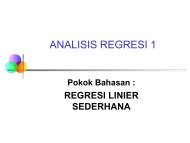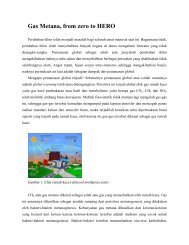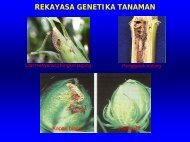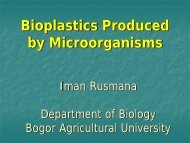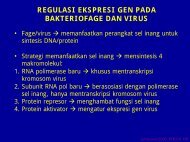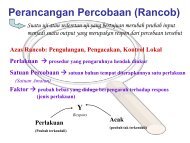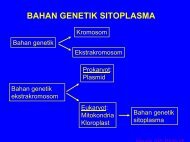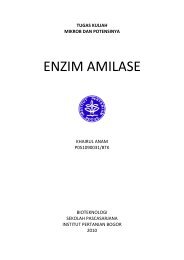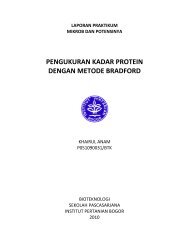An introduction of TAIL PCR
An introduction of TAIL PCR
An introduction of TAIL PCR
- No tags were found...
Create successful ePaper yourself
Turn your PDF publications into a flip-book with our unique Google optimized e-Paper software.
<strong>An</strong> <strong>introduction</strong> <strong>of</strong> <strong>TAIL</strong> <strong>PCR</strong>
Thermal Asymmetric Interlaced (<strong>TAIL</strong>)<br />
<strong>PCR</strong><br />
• A simple and powerful tool for the recovery <strong>of</strong><br />
DNA fragments adjacent to known sequences<br />
• Was developed by Liu and Whittier in 1995<br />
• Utilizes a set <strong>of</strong> nested sequence-specific<br />
primers together with a shorter arbitrary<br />
degenerate (AD) primer<br />
• The relative amplification efficiencies <strong>of</strong> specific<br />
and nonspecific products can be thermally<br />
controlled
Principle <strong>of</strong> <strong>TAIL</strong>-<strong>PCR</strong>
Important features <strong>of</strong> <strong>TAIL</strong>-<strong>PCR</strong><br />
• Primer design<br />
• <strong>An</strong>nealing temperature<br />
• Cycling orders
Primer Design<br />
• Specific primer (SP)<br />
• Nested sequence specific primer<br />
complementary to vector sequence<br />
• High melting temperature, T m =58-63 o C<br />
• Arbitrary degenerate (AD) primer<br />
– Relatively shorter<br />
– Lower melting temperature, T m =47-48 o C
<strong>An</strong>nealing Temperature<br />
• High-stringency cycle (thermal asymmetric)<br />
• <strong>An</strong>nealing temperature = 63 o C<br />
• Reduced-stringency cycle (thermal<br />
symmetric)<br />
• <strong>An</strong>nealing temperature = 44 o C<br />
• Low-stringency cycle<br />
• <strong>An</strong>nealing temperature = 30 o C
Protocol <strong>of</strong> <strong>TAIL</strong>-<strong>PCR</strong><br />
SP1 SP2 SP3<br />
AD primer<br />
vector<br />
insert<br />
nontarget sequence<br />
(A)Primary <strong>PCR</strong> with SP1 and AD<br />
5 high stringency cycles<br />
1 low stringency cycle
Protocol <strong>of</strong> <strong>TAIL</strong>-<strong>PCR</strong><br />
10 reduced stringency cycles<br />
1 reduced stringency cycle<br />
(thermal symmetric)<br />
<strong>TAIL</strong>-cycling<br />
(12 super cycles)<br />
2 high stringency cycles<br />
(thermal asymmetric)<br />
Specific product<br />
(type I)<br />
Nonspecific product<br />
(type II)<br />
Nonspecific product<br />
(type III)<br />
Product<br />
yield:<br />
High or middle<br />
(detectable or undetectable)<br />
High<br />
(detectable)<br />
Low<br />
(undetectable)
<strong>PCR</strong> Product <strong>of</strong> Primary Reaction<br />
Type II<br />
Type I<br />
Type III<br />
Liu & Whittier, 1995
Protocol <strong>of</strong> <strong>TAIL</strong>-<strong>PCR</strong><br />
(B) Secondary <strong>PCR</strong> with SP2 and AD (10 super cycles)<br />
•1000-fold dilution <strong>of</strong> primary <strong>PCR</strong> product<br />
Specific product<br />
Nonspecific product (type III)<br />
Product<br />
yield:<br />
High (detectable)<br />
Very low (undetectable)
<strong>PCR</strong> Product <strong>of</strong> Secondary Reaction<br />
Type I<br />
Type II<br />
Type III<br />
Liu & Whittier, 1995
Protocol <strong>of</strong> <strong>TAIL</strong>-<strong>PCR</strong><br />
(C) Tertiary <strong>PCR</strong> with SP3 and AD (20 normal cycles)<br />
•1000-fold dilution <strong>of</strong> secondary <strong>PCR</strong> product<br />
Specific product<br />
Agarose gel analysis<br />
Direct sequencing
Cycling Orders<br />
Liu & Whittier, 1995
Application
High efficiency to amplify insert end<br />
segments from P1, BAC and YAC clones<br />
• <strong>TAIL</strong>-<strong>PCR</strong> as a powerful tool for amplifying<br />
insert end segments from P1, BAC and YAC<br />
clones<br />
• The amplified products were highly specific and<br />
suitable as probes for library screening and as<br />
templates for direct sequencing<br />
• The recover insert ends can also be used for<br />
chromosome walking and mapping
P1 clones<br />
Liu & Whittier, 1995
YAC clones<br />
Liu & Whittier, 1995
BAC clones<br />
Liu & Huang, 1998
High efficiency to amplify insert end<br />
segments from P1, BAC and YAC clones<br />
• Many product bands from the primary <strong>TAIL</strong>-<strong>PCR</strong><br />
reaction disappeared after the secondary <strong>TAIL</strong>-<strong>PCR</strong>,<br />
indicating that these were non-specific type II<br />
products<br />
• Specific products were not always seen in the<br />
primary reactions due to their low concentration.<br />
However, these specific products becomes visible<br />
after the subsequent secondary reaction
Direct Sequencing<br />
• Because it’s high specificity, unpurified<br />
<strong>TAIL</strong>-<strong>PCR</strong> products can be directly<br />
sequenced.<br />
• Unpurified products yielded clear<br />
sequencing pr<strong>of</strong>iles
Recovery single-copy sequences from highly<br />
complex genome<br />
• Amplification <strong>of</strong> single copy sequences was found<br />
technically more difficult in organisms with large<br />
genome. e. g. Inverse <strong>PCR</strong> is difficult to apply to<br />
genomes containing over 10 9 bp<br />
• However, <strong>TAIL</strong>-<strong>PCR</strong> is very sensitive and can be<br />
applied to highly complex genomes
Recovery single-copy sequences from highly<br />
complex genome<br />
Liu , et al, 1995
Rapid isolation <strong>of</strong> promoter sequences<br />
• The isolation <strong>of</strong> promoter and enhancer<br />
sequences is a crucial step in the study <strong>of</strong><br />
the regulation <strong>of</strong> gene expression<br />
• Flanking regions <strong>of</strong> genes, containing<br />
these elements, were conventionally<br />
isolated by screening genomic libraries<br />
using cDNA as probes, which is very timeconsuming
Rapid isolation <strong>of</strong> promoter sequences<br />
• Therefore, simpler and more reliable, and<br />
preferably <strong>PCR</strong>-based methods for<br />
promoter isolation are urgently required.<br />
• Unlike Inverse <strong>PCR</strong> and ligation-mediated<br />
<strong>PCR</strong>, <strong>TAIL</strong>-<strong>PCR</strong> is a simple and efficient<br />
technique for genomic walking which does<br />
not require any restriction or ligation steps.
Conclusion<br />
• <strong>TAIL</strong>-<strong>PCR</strong> is highly specific and efficient<br />
for amplification <strong>of</strong> DNA segments<br />
adjacent to known sequences<br />
• Upon different modification, this technique<br />
could be used to handle vary tasks:<br />
• Amplification <strong>of</strong> Insert Ends fragments<br />
from P1, YAC and BAC clones for<br />
chromosome walking
Application <strong>of</strong> <strong>TAIL</strong> <strong>PCR</strong><br />
• Isolation <strong>of</strong> 5’ flanking region <strong>of</strong> genes<br />
• Isolation <strong>of</strong> promoter sequences<br />
• Isolation <strong>of</strong> T-DNA insert junctions<br />
• for genome physical mapping,<br />
development <strong>of</strong> sequence-tagged sites<br />
(STS), and analysis <strong>of</strong> genomic<br />
sequences flanking T-DNA, transposon or<br />
ritrovirus insertions.
Advantages<br />
1) Simplicity<br />
2) High specificity<br />
3) High efficiency<br />
4) Speed<br />
5) Less risks in chimeric artifacts<br />
6) Direct sequencing<br />
7) High sensitivity<br />
Liu & Whittier, 1995
1) Simplicity<br />
• neither special DNA manipulations before<br />
<strong>PCR</strong> (restriction digestion, ligation, etc) nor<br />
laborious screening afterward (Southern<br />
hybridization, primer labelling and extension,<br />
gel excision, etc)<br />
• simple agarose gel analysis can confirm<br />
product specificity<br />
• the requirement for the template DNA<br />
quantity (~ng) and purity are extremely<br />
modest
2) High specificity<br />
• the proportion <strong>of</strong> coamplified nonspecific<br />
products is very low<br />
3) High efficiency<br />
• 60-80% <strong>of</strong> reactions yielded specific products<br />
with any given AD primer<br />
4) Speed<br />
• The successive amplification reactions can all<br />
be completed in 1 day
5) Less risks in chimeric artifacts<br />
• <strong>TAIL</strong> <strong>PCR</strong> doesn't involve ligation step<br />
6) Direct sequencing<br />
• The high specific reaction products can be<br />
added directly to the sequencing reaction , no<br />
gel excision and purification are required<br />
7) High sensitivity<br />
• Single-copy sequences in genome can be<br />
amplified



